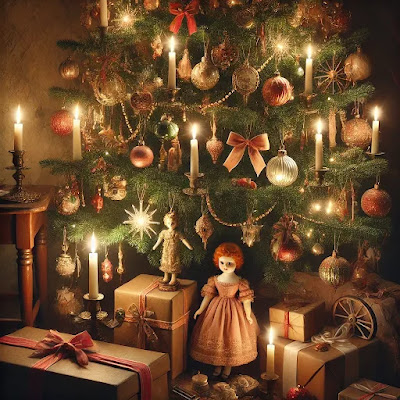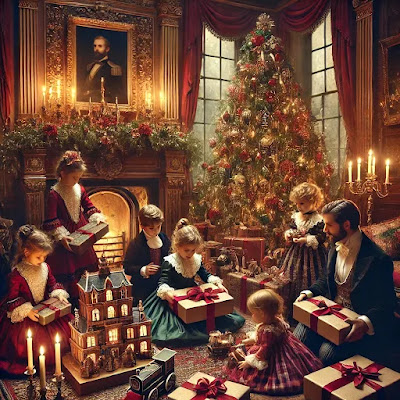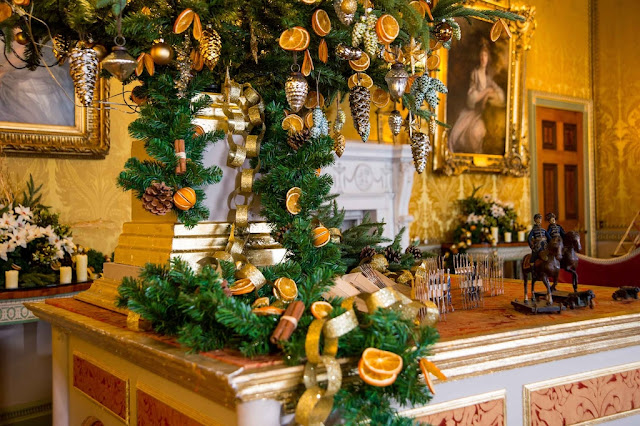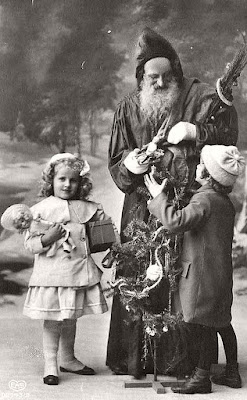Christmas in the Victorian era was a time when many of the holiday traditions we recognize today began to take shape, thanks in part to Queen Victoria and Prince Albert, whose love for Christmas helped popularize the holiday. Here's an overview of how Christmas was celebrated during this time
1. Christmas Tree
.webp) |
| Christmas tree in Victorian era (Ai photos) |
 |
| Christmas tree in Victorian era (AI photos) |
 |
| Typical Victorian era Christmas tree |
 |
| Christmas tree in late Victorian era |
 |
| Victorian era Christmas tree (AI photo) |
 |
| Victorian era Christmas tree(Ai photo) |
The Christmas tree became widely popular in Britain during the Victorian era, particularly after an illustration of Queen Victoria, Prince Albert, and their children around a Christmas tree was published in 1848. Prince Albert, who was of German descent, brought the tradition of decorating a tree with candles.
 |
| Victorian era Christmas tree (AI photo) |
 |
| Victorian era Christmas tree (Ai photo ) |
 |
| Victorian Christmas tree (AI photo) |
 |
| Victorian era Christmas tree (Ai photo) |
Victorian era Christmas tree were decorate with candle,Cranberry and popcorn garland,paper decorations,Dried Orange,Edible treat such walnut,candycane,Gingerbread, glass ornaments,Pinecones and small gifts.
2. Christmas Cards
 |
| Victorian era Christmas card |
The tradition of sending Christmas cards also began in the Victorian era. The first commercial Christmas card was created in 1843 by Sir Henry Cole. It featured a festive family scene and the greeting "A Merry Christmas and a Happy New Year to You."
3. Caroling
 |
| Christmas caroling (Illustrated) |
 |
| Victorian Christmas Caroling (Illustrated) |
 |
| Christmas Caroling in Victorian era (AI photo) |
 |
| Victorian era Christmas Caroling ( AI photo) |
 |
| Kids sing Christmas Carol in Victorian era ( AI photo) |
Carol singing was a popular Victorian Christmas activity. Groups of carolers would go door-to-door singing traditional carols such as "God Rest Ye Merry, Gentlemen" and "Hark! The Herald Angels Sing," hoping to receive a small treat or donation.
4. Christmas Dinner and Treat
 |
| Victorian era Christmas dinner (Illustrated) |
 |
| Victorian era Christmas dinner(Illustrated) |
 |
| Family eat Christmas food in Victorian era(AI photo) |
 |
| Victorian era Christmas feast ( AI photo) |
 |
| Victorian era Christmas feast (Ai photo) |
The Victorian Christmas feast was elaborate and plentiful, with roast goose or turkey or Sawn as the centerpiece. Other foods included mince pies, plum pudding (often referred to as Christmas pudding),Hot custard,Roasted seasonal nuts and vegetables and mulled wine. Wealthier families could afford more lavish meals, while poorer families would have simpler dishes.
 |
| Victorian era Christmas food (AI photo) |
Christmas candy and Cookies are also popular as treat. Popular candies was- Ribbon Candy, Hard Candy and candycane.And popular cookies was Gingerbread and shortbread.
5. Gift Giving
 |
| Victorian era Christmas gift giving (Illustrated) |
 |
| Victorian era Christmas gift giving (Illustrated) |
 |
| Kids received Christmas gift in Victorian Era |
 |
| Kids receive Christmas gifts in Victorian era (AI photo) |
 |
| Kids receive Christmas gifts in Victorian era (AI photo) |
 |
| Kids receive Christmas gifts in Victorian era (AI photo) |
 |
| Kids receive Christmas gifts in Victorian era (AI photo) |
 |
Kids receive Christmas gifts in Victorian era (Illustrated)
|
The Victorians began the practice of exchanging gifts during Christmas, although initially, gifts were simple and often handmade. Over time, gifts became more elaborate, especially for children, with toys like dolls, books, and tin soldiers becoming popular.
6. Crackers
 |
| Kids pop Christmas crackers (Illustrated) |
 |
| Victorian era Christmas crackers (AI photo) |
Christmas crackers, invented by Tom Smith in the 1840s, became a popular Victorian tradition. These festive items, which make a popping sound when pulled apart, usually contain small toys, paper crowns, and jokes or riddles.
7. Charity and Helping the Poor
 |
| Christmas charity in Victorian era |
The spirit of goodwill and charity was an important part of Victorian Christmas celebrations. Many people, inspired by Charles Dickens' A Christmas Carol (published in 1843), were moved to give to the poor and less fortunate during the holiday season.
8. Christmas Decorations
 |
| Victorian era Christmas decoration |
 |
| Victorian era Christmas decoration |
 |
| Victorian era Christmas wreath (AI photo) |
 |
| Victorian era Christmas tree (AI photo) |
 |
| Victorian era Christmas tree( AI photo) |
 |
| Victorian era Christmas tree ( AI photo) |
 |
| Family take photos under Christmas tree in Victorian era |
Along with the Christmas tree, homes were decorated with evergreen branches, Pinecone,cinnamon,Dried Orange,holly, ivy, and mistletoe. These natural decorations brought the outdoors inside and added a festive touch to Victorian homes.
9. Christmas Pantomimes and Theater
 |
| Theater are popular Christmas entertainment during Victorian era (Illustrated) |
 |
Christmas dance were very popular in Victorian era(AI photos)
|
The Victorians loved going to the theater during the Christmas season, and pantomimes were particularly popular. These light-hearted, family-friendly performances often featured fairy tales, slapstick comedy, and audience participation.
Christmas ballroom formal dance were very popular in Victorian era.
10. SANTA CLAUS AND FATHER CHRISTMAS
 |
| Kids cut Christmas cake with Santa claus in Victorian era (AI photo) |
 |
| Kids receive Christmas gifts from Santa claus in Victorian era |
Santa Claus became quite popular during the Victorian era (1837–1901). The Victorian period played a significant role in shaping modern Christmas traditions, including the figure of Santa Claus. Here are some key points about his rise to popularity during this time:
1. Influence of "A Visit from St. Nicholas": The 1823 poem, often attributed to Clement Clarke Moore, popularly known as "The Night Before Christmas," helped cement the image of Santa Claus as a jolly, rotund, and gift-giving figure. This image became widely embraced during the Victorian era.
2. Victorian Christmas Traditions: Queen Victoria and Prince Albert's embrace of Christmas traditions, such as the Christmas tree, helped popularize many festive customs. As Christmas became more centered on family, Santa Claus evolved into a key figure for children and family-oriented celebrations.
 |
| Victorian kids with Santa claus |
3. Charles Dickens’ Influence: Dickens' works, especially "A Christmas Carol" (1843), reinforced the idea of Christmas as a time of generosity and goodwill. Although Santa isn't mentioned directly, Dickens' depiction of the holiday spirit contributed to Santa Claus becoming associated with charitable giving and joy.
4. Illustrations and Media: Victorian-era illustrations, particularly those by artists like Thomas Nast, who began drawing Santa Claus for Harper's Weekly in the 1860s, further solidified Santa's modern image with a white beard, red suit, and a sleigh.
By the late Victorian era, Santa Claus had become an integral part of Christmas celebrations in many Western countries, thanks to literature, media, and evolving family customs.
Santa Claus, or figures representing him, became a notable presence at Victorian Christmas parties, especially for children. While the concept of inviting Santa Claus in the way we think of today (with a person dressed as Santa) wasn't as widespread, Santa's role as a gift-bringer was integral to the celebrations, particularly in middle-class Victorian homes.
Here’s how Santa Claus or his equivalent was involved in Victorian Christmas parties:
1. Gift-Giver: Santa Claus was seen as the bringer of presents, and children eagerly awaited his arrival on Christmas Eve. The idea of Santa delivering presents down the chimney and leaving them in stockings became a central part of Victorian Christmas festivities. In this sense, Santa was symbolically "invited" into the home to bring joy and surprise for children.
 |
| Victorian Santa claus Illustrated |
2. Father Christmas: In Britain, the figure of Father Christmas—an older, more traditional representation of the holiday spirit—was also popular. He embodied the festive cheer of the season, and sometimes actors or family members would dress as Father Christmas at parties to entertain guests, particularly children.
 |
| Kids received Christmas gift form santa Claus (AI photo) |
3. Christmas Entertainers: Some wealthier Victorian households would hire actors or entertainers dressed as festive characters, possibly including Santa Claus or Father Christmas, to make appearances at Christmas gatherings. These characters would hand out small gifts or sweets to children and cut Christmas cake with kids.
 |
| Victorian kids with Santa claus |
4. Christmas Cards and Decorations: Images of Santa Claus or Father Christmas frequently appeared on Christmas cards and decorations during the Victorian era, which helped further integrate the figure into the cultural celebration. While he may not have been physically present at every party, his image and spirit were certainly part of the festivities.
In essence, while Santa may not have been "invited" in the way we think of today (with a Santa impersonator), his presence as a gift-giver and symbol of Christmas cheer was an important part of Victorian holiday gatherings.
Victorian Christmas traditions were marked by a mix of family gatherings, charity, and the creation of holiday customs that remain central to modern Christmas celebrations.
.webp)


















































Comments
Post a Comment